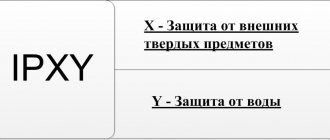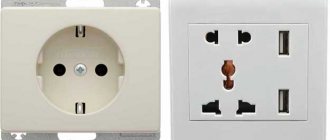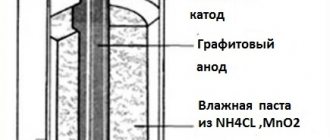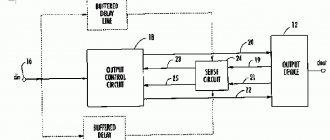Degree of protection IP (International/Ingress Protection Rating) is a classifier of degrees of protection that regulates the penetration of foreign objects - dust and water in accordance with the international standard IEC 60529 (DIN 40050, GOST 14254-96).
All electrical devices are assigned a certain degree of IP protection, depending on the equipment installed on the product. The housing of an electrical product may contain different elements with different degrees of IP protection. As a result, the IP protection degree of an electrical product is determined by the installed equipment that has the lowest IP protection degree.
The degree of protection is indicated by two letters IP and two numbers indicating the degree of protection. Penetration of solid mechanical objects is indicated by the first number, the second number indicates the resistance of the equipment to liquids.
Protection class IP 68.
The most common degrees of protection are IP20, IP44, IP54, IP65.
- IP20 - Electrical equipment with a degree of protection of IP20 is usually used indoors.
- IP44 - Used in a room with high humidity, for example, in a bath, it is worth installing devices with a degree of protection IP44.
- IP54 - Common degree of protection for electrical components.
- IP55 - Most often, manufacturers of electrical cabinets and panels indicate the degree of protection IP55.
- IP65, IP67, IP68 - Requirements for equipment exposed to weather conditions. Equipment with a degree of protection IP68 can be immersed in water; the depth of immersion is indicated additionally.
What does IP68 mean and how is it certified?
IP protection rating is a standard by the International Electrotechnical Commission, or IEC, that establishes a classification system for degrees of protection in electronic devices and equipment.
The IEC's main goal in creating this system is to offer the user an accurate reference when it comes to understanding how robust their device is, thereby preventing manufacturers from using imprecise terms to indicate the level of protection of their devices.
Therefore, depending on how well—or poorly—a device is isolated from solids or liquids, it receives a certificate appropriate to its level.
Certifications are established using codes with the structure "IPXX", where the first digit refers to protection against solid particles and the second refers to resistance to liquids. In the decryption you can see what each of the numbers means in the degree of IP protection.
Protection class IP 68.
The most common degrees of protection are IP20, IP44, IP54, IP65.
- IP20 - Electrical equipment with a degree of protection of IP20 is usually used indoors.
- IP44 - Used in a room with high humidity, for example, in a bath, it is worth installing devices with a degree of protection IP44.
- IP54 - Common degree of protection for electrical components.
- IP55 - Most often, manufacturers of electrical cabinets and panels indicate the degree of protection IP55.
- IP65, IP67, IP68 - Requirements for equipment exposed to weather conditions. Equipment with a degree of protection IP68 can be immersed in water; the depth of immersion is indicated additionally.
What is IP68 waterproof?
IP (Internation Protection - international protection codes or Ingress Protection - from the English ingress protection) is a globally accepted standard for measuring the degree of protection of a device from dust and water getting inside. The first digit of the two-digit IP code indicates the degree of protection against solid objects, including dust. The second digit indicates the degree of protection against fresh water.
Thus, if a smartphone meets the IP68 standard, the dust protection level is six, and the water protection level is eight. As for the numbers themselves, they are deciphered as follows:
Protection from solid objects
IP1x - Protection against solid objects, diameter >50 mm
IP2x - Protection against solid objects, diameter >12.5 mm
IP3x - Protection against solid objects with a diameter >2.5 mm
IP4x - Protection against solid objects with a diameter >1 mm
IP5x - Partial dust protection
IP6x - Full dust protection
Water protection
IPx1 - Protection against vertically dripping water
IPx2 - Protection against dripping water at an angle of 15°
IPx3 - Rain and splash protection up to 60°
IPx4 - Splashproof from any angle
IPx5 - Protected against low pressure water jet for 3 minutes
IPx6 - Protected against strong water jets for at least 3 minutes
IPx7 - Protection against water penetration when the device is immersed to a depth of 1 meter for 30 minutes
IPx8 - Immersion protection greater than 1 meter for more than 30 minutes
It would seem that IP68 protection should be enough for such a simple task as taking a photo in a children’s pool at a depth of 30 cm. But, nevertheless, some smartphones do not withstand such a “test,” which brings us to the next logical question:
Why doesn't the degree of protection always work in real life?
There are several reasons for this. The fact is that testing to obtain an IP certificate takes place under strictly controlled laboratory conditions. The device is placed in a small container of fresh water, after which it is slowly lowered to a depth of up to one and a half meters. After half an hour, it is carefully taken out of the water and checked for functionality.
But in real life everything looks a little different. We do not always slowly and very carefully lower a smartphone under water or take it out of the water. But with a sudden dive, even to a shallow depth (or actively using a smartphone underwater), pressure may arise that exceeds the norm.
The second reason is how exactly manufacturers protect the smartphone from water penetration. For example, when you take out the SIM card tray of any waterproof phone, you will see a rubber seal. And any gasket or seal is a consumable item.
High temperatures (leaving a smartphone in a car during 35-degree heat) and a number of other factors can affect the quality of such a seal. Moreover, over time, it loses its properties (micro cracks may appear), which causes the seal of the device to be compromised.
In the watch industry there is a procedure called repassage. Each model of mechanical watch must undergo regular maintenance, including the replacement of seals and all kinds of gaskets. It is done once every 3-5 years or a little less often (depending on the brand and cost of the watch). Even the most reliable diving watch (which can withstand pressure at depths of over 500 meters) will lose its properties if it is not maintained regularly. Naturally, no one ever does such procedures for waterproof smartphones.
So is it possible to immerse an IP68 protected smartphone under water?
On YouTube you can see thousands of videos of waterproof smartphones being subjected to all sorts of tests (from immersion in soda to sea water), after which they continue to work as normal. Does this mean that nothing will happen to your smartphone? Of course not.
In the case of YouTube tests, no immediate problem may occur, even if liquid gets inside the device, thereby starting slow oxidation processes.
Moisture protection is just a safety net “just in case.” And you shouldn't use your smartphone as an underwater camera without special underwater cases.
The previously mentioned Sony company makes its smartphones “waterproof” so that you can:
- Talking on the phone in the rain
- Use the device with wet hands
- Rinse your smartphone with tap water after using it in a dusty environment (sandy beach in windy weather, dusty country road)
- Watch a video while working in the kitchen (when splashes from the faucet may get on your smartphone)
Every time you submerge your smartphone under water, you risk damaging it. There are countless similar examples. And if your smartphone does not break down after the next “bathing”, this does not mean at all that it will always be like this.
Neither the IP68 standard nor any smartphone manufacturer guarantees safe use of the device underwater. Don't forget that laboratory tests are very different from real life.
Indexing: IP68 degree of protection
The absolute leader in the entire line of possible protective indicators is IP68. As we can judge, this is the maximum level of protection a device can have in principle.
Indexing analysis:
- Marker 6 means maximum protection from dust and solid objects;
- Marker 8 symbolizes that the moisture protection of the mechanisms from the penetration of water and moisture is maximum (waterproof);
- These are products that can be used in water up to 1 meter deep, for an unlimited amount of time.
In addition to those discussed, there are also others: IP54, IP66, IP55, IP23, IP21, IP56, IP33, IP64, IP57, IP53, IP31, IP43, IP24, IP69, IP52, IP41, IP34, IP22, IP32, IP58, IP63, IP53 , IP45, IP42, IP67.
IP protection. Digital index.
| Protection class IP | IP x0 | IP x1 | IP x2 | IP x3 | IP x4 | IP x5 | IP x6 | IP x7 | IP x8 | IP x9 | |
| No protection | Protection from vertically falling drops of water | Protection against water drops falling at an angle of 15° from the vertical | Rain protection | Splash protection | Protection against pressurized water splashes | Protection against powerful water jets | Protection from water ingress during immersion to a certain depth and time | Protection against flooding (depth is indicated additionally, in m.) | Water for steam/high pressure cleaning | ||
| IP 0x | No protection | IP00 | |||||||||
| IP 1x | Particle protection > 50.0 mm | IP10 | IP11 | IP12 | |||||||
| IP 2x | Particle protection > 12.5 mm | IP20 | IP21 | IP22 | IP23 | ||||||
| IP 3x | Particle protection > 2.5 mm | IP30 | IP31 | IP32 | IP33 | IP34 | |||||
| IP 4x | Particle protection > 1.0 mm | IP40 | IP41 | IP42 | IP43 | IP44 | |||||
| IP 5x | Protection against dust | IP50 | IP54 | IP55 | |||||||
| IP 6x | Completely protected from dust | IP60 | IP65 | IP66 | IP67 | IP68 | IP69K |
An increase in one of the protection indicators correspondingly leads to an increase in the other (for example, a product that can be temporarily immersed in water is protected enough to completely keep out dust).
Therefore, only the above combinations of IP protection levels can exist. It is not possible to have a degree of protection such as IP28.
IP protection. Letter index.
The additional letter indicates the degree of protection of people from access to dangerous parts and is indicated if:
- The actual degree of protection against access to hazardous parts is higher than the degree of protection indicated by the first characteristic digit;
- Only protection against the harmful effects of water is indicated, and the first characteristic digit is replaced by the symbol “X”. The additional letter "A" indicates that the enclosure provides protection against access to hazardous parts with the back of the hand, "B" with a finger, "C" with a tool, and "D" with a wire.
| Letter | Impact. |
| A | back of hand |
| B | finger |
| C | tool |
| D | wire |
- The auxiliary letter “H” is intended to indicate high-voltage electrical equipment.
- The additional letters "M" and "S" indicate that the equipment, when tested to comply with the degree of protection against harmful effects due to ingress of water, with moving parts is in a state of motion or stationary, respectively.
| Letter | Meaning |
| N | High voltage equipment |
| M | During water protection tests, the device moves |
| S | During water protection tests, the device is stationary |
| W | Weather protection. |
- The degree of protection of the enclosure can be indicated by an additional letter only if it satisfies all lower levels of protection, for example: IP1XB, IP1XC, IP1XD, IP2XC, IP2XD, IP3XD.
Decoding the degree of protection
The marking includes numbers from 1 to 9, and an increase in the serial number of the code indicates an increase in the degree of protection. Dust and moisture protection, according to the classifier, ranges from IP00, when the structure is completely unprotected, to IP 69 with the maximum level of safety.
If tests have not been carried out for any parameter, then the manufacturer is obliged to inform the consumer accordingly, that is, reflect it in the labeling by putting an “x” sign, for example, IP5X.
First digit
The first symbol characterizes protection from dust and mechanical objects. The larger the number, the smaller the resistance to smaller objects is guaranteed:
- 0 – complete lack of protection;
- 1 – protection from accidental touches, large objects (50 mm), lack of protection from deliberate influence;
- 2 – protection against contact with fingers and objects larger than 12.5 mm;
- 3 – it is guaranteed that tools, cables and particles larger than 2 mm cannot enter;
- 4 – impossibility of ingress of wires, fasteners and particles larger than 1 mm;
- 5 – partial protection against dust, which does not affect the performance of the device;
- 6 – full guarantee against dust.
The sixth class guarantees complete protection against any possible contact of parts of the human body with the elements of the device.
Second digit
The second digit of the marking carries broader information, since it guarantees protection from moisture (drops, splashes) and immersion in water. Normal functioning is ensured both during interaction with unfavorable factors and after that.
Important! Waterproof and waterproof have different meanings, with the second property providing greater reliability. Waterproof watch
Waterproof watch
In this case, classification is complicated by the fact that splashes of water can hit the device from any direction; accordingly, protection must ensure the operability of the devices in all situations. The class table looks like this:
- 0 – no protection;
- 1 – normal operation of the device when vertical drops of water enter;
- 2 – operation of the device when drops are deflected at an angle of up to 15⁰;
- 3 – protection from rain splashes at an angle of up to 60⁰ to the vertical;
- 4 – splashes from any direction are allowed;
- 5 – protection from continuous jets of water;
- 6 – improved protection against jets (strong jets are allowed);
- 7 – normal operation during short-term immersion in water to a depth of 1 m;
- 8 – normal operation with a duration of stay in water of up to half an hour at an immersion depth of up to 1 m;
- 9 – protection against high-temperature, high-pressure water jets.
According to the data provided, the highest and most common degree of protection is provided for equipment of the IP 68 class. IP 69 devices are used in car washes and similar enterprises. For domestic use, the ip67 class is quite sufficient, since according to the degree of protection ip67, the decryption should mean:
- the device body ensures that dust cannot get inside;
- Accidental exposure of the device to water will not disrupt operation.
Note! The above classification does not have a position that guarantees the operability of the structure when in water for a period of one hour or more. This requirement is satisfied by following the standards for military equipment
In addition, such standards provide for a higher degree of reliability when exposed to physical stress (impacts, accelerations).
Additional letters
In the event that the degree of protection is increased compared to the classification, or does not fall under the classification (first digit X), then an alphabetic symbol may be added after the digital designation:
- A – protection against touching the back of the hands;
- B – finger protection;
- C – impossibility of touching with the tool;
- D – impossibility of wire penetration;
- H – symbol for designating high-voltage equipment;
- S – device operation during water resistance tests;
- M – switching off the device for the duration of the test;
- W – resistance to other weather conditions.
Note! There is a flaw in the classification that devices that can withstand immersion in water may be poorly protected from water jets. Therefore, for structures that fall under several classes simultaneously, double marking is allowed, which is indicated through a fraction sign, for example, IP65 / IP68
IP69K standard
The German standard DIN 40050-9 has extended IEC 60529 to IP69K protection level. This degree of protection is used for washing at high liquid temperatures and under high pressure. The housings are designed not only to provide strong dust protection (IP6X), but also to withstand prolonged exposure to high-pressure water jets.
The IP69K degree of protection was originally developed for vehicles and road equipment, especially those that require regular intensive cleaning (dump trucks, concrete mixers, etc.), but today it is also used in other areas (chemical industry and food industry).
Go to catalog overview











